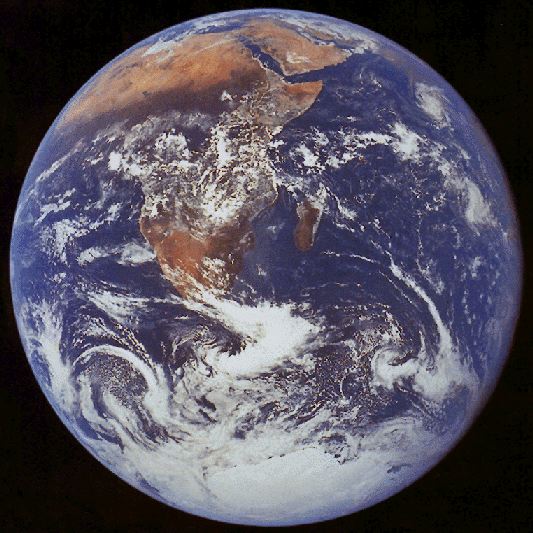The Earth has two neighboring "
terrestrial" planets, compact and rocky, with significant atmospheres. They're places you can stand on, with climates, of a sort. What about them?
 The first planet inward from the Sun is Venus,
The first planet inward from the Sun is Venus, with a mass, size, and surface gravity similar to Earth's. But its atmosphere is wildly different - a CO2-dominated nightmare of extreme pressure and temperatures: at the surface, 92 Earth atmospheres and 735
oK = 462
oC = 864
oF. The middle and upper atmosphere is thick with CO2 and sulfur compounds that reflect over 3/4 of the incoming sunlight. The atmosphere also has significant levels of nitrogen and sulfur dioxide, as well as tiny amounts of water vapor and argon. The most natural assumption is that the CO2 outgassed from the solid planet early in Venus' history and never returned into the planet's interior - a very different story from the Earth's, in spite of the presence of other gases familiar from our atmosphere (nitrogen, argon, water vapor). The absence of oxygen, on the other hand, is exactly what we should expect: there's no plant life on Venus to exhale it.
Venus was once a science fiction favorite for a quasi-Earth setting. But remote measurements of Venus' atmosphere started in the 1950s, greatly augmented by
visiting spacecraft operating
in situ, and dashed the hopes of astronomers, biologists, and science fiction writers alike for an Earth twin. Trying to understand why a planet so similar to Earth ended up with such a radically different fate then became a cottage industry. Based on a few plausible assumptions, reasonable explanations have been worked out.
Venus is about 28% closer to the Sun than the Earth, and so it receives more solar radiation. But by itself, that cannot explain its extreme surface temperature. The atmosphere-free baseline surface temperature is 327
oK -
corresponding to the 279
oK figure for the Earth. But with an albedo of 76%, Venus' surface temperature - absent any CO2 opacity or downward cloud reflectivity - would be a mere 229
oK, lower than Earth's reflective-clouds-only temperature of 250
oK.
Most of the extreme temperature is simply due to the sheer thickness of Venus' atmosphere. There's so much CO2 that the effective opacity of a vertical column of Venusian atmosphere is about 110 times that of the Earth's.* The opacity of a single CO2 molecule itself is increased because of the extreme pressure it experiences from surrounding CO2 molecules.** Additional enhancement of the surface temperature comes from sulfur compound cloud reflectivity bouncing infrared (IR) radiation back towards the surface (instead of absorbing and re-radiating it upwards).
Plate tectonics on the Earth are driven by interior heat released by radioactive decay. Venus' plate tectonics - if it ever had any - stopped a long time ago. That, plus the absence of water oceans and plants, meant the CO2 kept building up in the atmosphere.
Runaway greenhouses and more runaway metaphors. For historical reasons, major confusion once surrounded the theory of Venus' extreme temperatures. Going under the name of "runaway greenhouse," this theory is often misinterpreted as explaining Venus' extreme temperatures
today as a function of its hypothetical
past. But the vertical temperature profile of Venus' atmosphere requires knowing nothing about its past; it only requires knowing its
present composition, heat flow, and surface gravity - just like Earth. The lower third of Venus'
vertical temperature profile is dominated by
radiative opacity, like the interior of a star - so much so, that even the gravity-work effect that is basic to the Earth's temperature profile is negligible by comparison. In the middle and upper Venusian atmosphere, the air is thinner, and gravity is the main factor controlling the temperature lapse rate.
There was a point to the "runaway greenhouse," however. If you make the plausible assumption that Venus started as a proto-planet with as about much water as the Earth, the striking fact that there's almost no water in Venus' atmosphere today demands explanation, and the "runaway greenhouse" met that demand. Liquid surface water evaporated and floated up (just as it does here), but because Venus' temperatures were always higher to start with, it had hard time condensing into clouds. Instead, the water vapor kept going, into Venus' upper atmosphere, where the
deadly solar ultraviolet (UV) radiation dissociated the H2O into H and O2. Being very light atoms, the H's diffused away into space, while the O2's floated back down and reacted quickly with surface rocks. After a while, virtually all the water in Venus' atmosphere vanished in this way.
This mechanism should never have been called a "runaway greenhouse," because that makes it sound as if it has something to do with Venus' present extreme temperatures. It should have been called "runaway evaporation," followed by "catastrophic water loss." Some have even tried to rhetorically connect Venus' present extreme temperatures with climate change on Earth, which is absurd. The conditions on the two planets are so radically different, it's hard to see what direct application Venus' atmosphere has to ours. If it had the same thickness as ours, its surface temperatures would be only slightly larger than ours - instead of 2-1/2 times ours. That would be the hypertropical near-Earth twin envisioned in science fiction before circa 1950.
There is one important and relevant fact, though, that Venus does demonstrate. The temperature distribution of Venus' atmosphere shows far less relative variation than the Earth's. It is true that Venus barely rotates on its axis, but even so, there's little difference between say, poles and equator. This fact illustrates the "more uniformly hotter" principle mentioned in a previous posting. It's ultimately just the Second Law at work. Apart from an occasional sulfur compound shower, you would find "weather" on Venus very dull.
The
Earth's tropics are like this, only Venus is far more so.
 Our other neighbor, one planet outward from the Sun, is Mars.
Our other neighbor, one planet outward from the Sun, is Mars. Like Venus it has a CO2 atmosphere and very little water. But the similarities stop there: the Martian atmosphere is much thinner than Venus' and thinner even than ours. Mars is about 52% farther from the Sun than we are. The surface pressure and temperatures are a thin, frigid 0.008 atm and 227
oK = -46
oC = -51
oF (seasonal mean). If our tropics are a faint image of Venusian hell, then our Antarctica is a faint image of Mars' parched, cold desert. And our stratosphere matches Mars' surface in terms of very thin air.
Mars is Venus' opposite in other ways too. If Venus has little "weather," Mars suffers from too much - violent springtime sandstorms with winds exceeding 300 km/hr, and violent episodes of upward convection. At the same time, Mars has no liquid or evaporated water, so its climate suffers from larger extremes over the course of its day (similar to ours) and seasons (also similar, although about twice as long). The thinness of the atmosphere has something to do with that as well - very much the opposite of the climate boredom of Venus. But Mars has only a limited climate repertory, unlike Earth, mainly because of the lack of water vapor.
Mars is a smaller version of Earth in some ways, but small enough and with low enough surface gravity, that it had trouble over its history in holding on to much atmosphere. Because Mars' atmosphere is so thin, taking pictures of its surface from orbit is not hard. The latest and greatest are
these results from NASA's Mars Reconnaissance Orbiter.
And finally, we circle back to the Earth we now know so well. Our atmosphere is thinner than Venus', but thicker than Mars'. We're close to the Sun, but not too close.

And then there is the
extraordinary role of water, doing all the things we've learned about in the last few months: moderating temperature swings and variations,
dumping some extra heat into the atmosphere, raising lower atmosphere temperatures by its mild infrared opacity effect, but never leaving the Earth because it condenses and precipitates out below the stratosphere. The absence of significant liquid or evaporated water is the most obvious difference between our atmosphere and those of our neighbors - apart from the even more extraordinary, although thermodynamically less significant - persistence of oxygen, thanks to
plants.
And the Earth differs in less obvious but no less critical ways from Mars and Venus. It has the largest surface gravity of the three, making it easier for it to retain an atmosphere. And the continued functioning of plate tectonics, combined with persistent oceans, gets many gases out of the air (like CO2) and, chemically transformed, down to the ocean floors, where they're subducted back into the Earth's core from whence they came. The plate tectonics also wipe away the remains of meteor impacts so evident on Mars and our Moon. Finally, they drive the continents around, making geological and biological evolution on Earth much more complex.
The Earth's atmosphere has enough variety in its composition - plus the striking variety of behavior exhibited by just one compound - to keep its climate "interesting" - never dull like Venus', but not a limited, violent mood-swinger like Mars either.

---
* Actually, total IR optical depth. No one uses the correct "venerean" or "venereal" as the adjectival form of Venus, for obvious reasons.
** The IR absorption lines of the CO2 spectrum are broadened by the ambient pressure and "cover" more of the IR radiation in wavelength than a CO2 molecule in Earth's atmosphere.
Labels: astronomy/space, climate, evolution
 Successful science requires imagination, not just a piling up of facts. What keeps science from being no more than imagination is its critical aspect, a willingness to place one's own theories on the line and put them to the test of evidence and logic.
Successful science requires imagination, not just a piling up of facts. What keeps science from being no more than imagination is its critical aspect, a willingness to place one's own theories on the line and put them to the test of evidence and logic.
 Hegel's notion, thoroughly explored in his
Hegel's notion, thoroughly explored in his  * Or maybe not. There's strong evidence that about 600 Myr ago, the Earth did go through a "snowball" phase. But even then, the magical properties of water saved the day (or saved the epoch). Solid water (ice) is less dense than liquid, an unusual material property. So ice floats on top of liquid water, and the surface of an ocean or lake can freeze while life continues in the liquid below - amazing. That's enough for me to believe in a just and benevolent G-d on alternate Tuesdays
* Or maybe not. There's strong evidence that about 600 Myr ago, the Earth did go through a "snowball" phase. But even then, the magical properties of water saved the day (or saved the epoch). Solid water (ice) is less dense than liquid, an unusual material property. So ice floats on top of liquid water, and the surface of an ocean or lake can freeze while life continues in the liquid below - amazing. That's enough for me to believe in a just and benevolent G-d on alternate Tuesdays 

 And then there is the
And then there is the 



